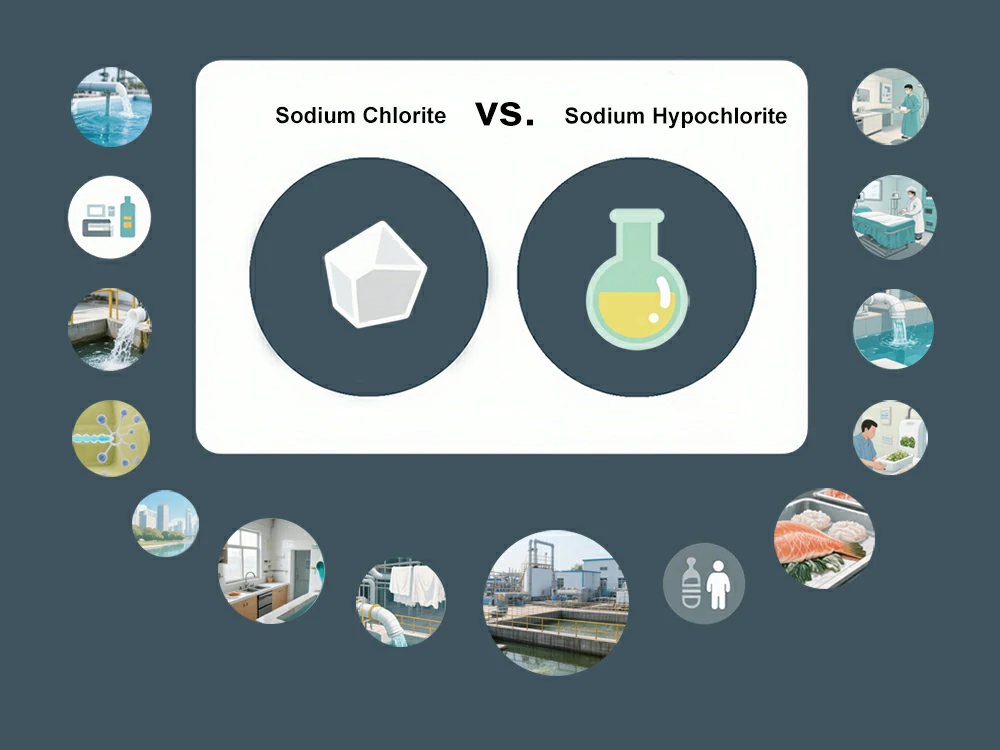Both sodium chlorite and sodium hypochlorite are widely used in water treatment and disinfection, but they are distinct chemical compounds used for different primary purposes, particularly in water treatment and disinfection.

1. Chemical Properties
Sodium Chlorite (NaClO₂): Sodium Chlorite is a white crystalline solid (or yellowish) that is a strong oxidant. In aqueous alkaline solutions, it is very stable; however, in acidic conditions, it forms chlorous acid, which quickly disproportionates to chlorine dioxide. It is primarily used as a precursor for the on-site generation of chlorine dioxide (ClO2), which is the actual active disinfectant or bleaching agent.
Sodium Hypochlorite (NaOCl): Sodium hypochlorite is a compound of sodium, oxygen, and chlorine. It is an alkaline inorganic chemical compound. In aqueous solutions, it is typically a pale greenish-yellow liquid with a characteristic chlorine smell. It’s the active ingredient in household bleach andis a strong oxidizing agent, directly used as a potent disinfectant, bleaching agent, and oxidizer.
2. Disinfection Mechanism
Sodium Chlorite: Sodium chlorite itself isn’t a strong disinfectant. It is converted into chlorine dioxide (ClO₂), which is highly effective for disinfection. Chlorine dioxide works by breaking down microbial cell walls and deactivating pathogens without producing harmful by-products like trihalomethanes.
Sodium Hypochlorite: Sodium hypochlorite releases free chlorine when it dissociates in water, which is a powerful oxidizing agent that can kill bacteria, viruses, and fungi. However, it can also produce undesirable by-products like chloramines, especially in chlorinated water systems.
3. Applications
Sodium Chlorite:
Water Treatment: Used for disinfection and purification of municipal water, eliminating tastes and odors, and controlling trihalomethanes, as it generally produces fewer harmful byproducts than chlorine/sodium hypochlorite. It is also effective against biofilms.
Industrial Bleaching: Extensively used for bleaching and stripping textiles, pulp, and paper.
Sanitization: Applied for sanitizing air ducts, HVAC/R systems, and various food contact surfaces.
Food Processing: Used as an antimicrobial treatment for various foods, including seafood, fruits, and vegetables.
Sodium Hypochlorite:
Disinfection: Widely employed for disinfection in sewage treatment, public water supplies, and swimming pools.
Household Use: The active ingredient in common household cleaners and laundry bleaches for disinfecting surfaces and removing stains.
Medical: Used in diluted forms for wound decontamination and in dental procedures (e.g., root canal irrigation).
Industrial: Applied in commercial laundering, paper and pulp manufacturing, and general surface decontamination.
4. Safety and Stability
Sodium Chlorite: Sodium chlorite solutions are generally stable when stored in a cool, dry environment, but once activated, the chlorine dioxide produced is unstable and must be used quickly. As a strong oxidant, it can be hazardous if mishandled or mixed with combustibles, potentially leading to explosive reactions.
Sodium Hypochlorite: Sodium hypochlorite is less stable over time, particularly in warmer conditions. It can lose its effectiveness over time, especially if exposed to light or heat. Releases toxic chlorine gas when mixed with acids (e.g., vinegar) and produces chloramines when mixed with ammonia-containing products.
5. Environmental Impact
Sodium Chlorite: Chlorine dioxide produced from sodium chlorite is less harmful to the environment compared to sodium hypochlorite. Produces fewer harmful disinfection byproducts (like THMs and HAAs).
Sodium Hypochlorite: Sodium hypochlorite can have a more significant environmental impact. Can form harmful disinfection byproducts such as Trihalomethanes (THMs) and Haloacetic acids (HAAs) in water treatment, which are regulated due to potential health concerns.
6. Advantages and Disadvantages:
Sodium Hypochlorite:
Widely available and generally cost-effective for initial setup and large-scale water treatment.
Effective against a broad spectrum of bacteria, viruses, and other microorganisms.
pH Sensitivity: Its effectiveness as a disinfectant can decrease significantly outside an ideal pH range.
Corrosiveness: Can be corrosive to equipment and infrastructure, especially metals.
Sodium Chlorite:
Broad pH Effectiveness: Chlorine dioxide (generated from sodium chlorite) remains effective over a wide pH range.
Less Corrosive: Generally less corrosive to equipment compared to sodium hypochlorite.
Biofilm Control: Highly effective against biofilms in water systems.
Generation Required: The active disinfectant, chlorine dioxide, must be generated on-site, which requires specific equipment and careful control of precursor chemicals.
Cost: Sodium chlorite itself can be more expensive than sodium hypochlorite, and the initial investment for chlorine dioxide generation equipment may be higher, although long-term operational costs can be lower.
Summary
Sodium Chlorite is a precursor to chlorine dioxide, which is a safer, more targeted disinfectant with fewer harmful by-products.
Sodium Hypochlorite is a more direct disinfectant, commonly found in bleach, but it can create harmful by-products like chloramines and is more corrosive.
If you need to minimize by-products and ensure a high level of disinfection, sodium chlorite (when activated to chlorine dioxide) is a better choice. For more routine disinfection, sodium hypochlorite may be more practical, especially in household or large-scale disinfection settings.


